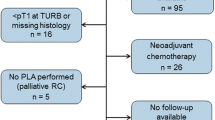Abstract
Purpose
To evaluate the clinical significance of incidentally detected bladder wall thickening (BWT) on computed tomography (CT).
Methods
A retrospective analysis was performed on 34,793 cystoscopy cases between January 2004 and December 2013. Among these, patients who underwent cystoscopy for the sole indication of incidentally detected BWT on CT were selected. Patients were categorized into the diffuse or focal group depending on the extent of BWT. Suspicious lesions on cystoscopy were biopsied to confirm histologic subtype. The incidence and predictive factors of bladder malignancy were examined.
Results
A total of 167 (0.5%) patients received cystoscopy for incidentally detected BWT on CT, of which 11 (6.6%) patients were diagnosed with bladder malignancy. When a suspicious lesion was identified on cystoscopy, 11 of 25 (44%) patients were found to have a bladder malignancy. Of the 15 patients with diffuse BWT, 5 (33.3%) were diagnosed with bladder malignancy, consisting of carcinoma in situ in 2 patients, high-grade carcinoma in 2 patients and muscle invasive disease in 1 patient. Of the 10 patients with focal BWT, 6 (60.0%) were diagnosed with bladder malignancy, of which 3 patients had high-grade disease. On multivariate logistic regression analysis, focal BWT [95% confidence interval (CI) 1.400–25.357, P = 0.016] and atypical cells in urine cytology (95% CI 2.631–63.446, P = 0.002) were positively associated with bladder malignancy.
Conclusions
Incidentally detected BWT on CT can be suggestive of bladder malignancy. Therefore, further work-up including cystoscopy and urine cytology should be performed to assess bladder malignancy.


Similar content being viewed by others
References
Burger M, Catto JW, Dalbagni G et al (2013) Epidemiology and risk factors of urothelial bladder cancer. Eur Urol 63:234–241
Jung KW, Won YJ, Oh CM et al (2016) Prediction of cancer incidence and mortality in Korea, 2016. Cancer Res Treat 48:451–457
Babjuk M, Burger M, Zigeuner R et al (2013) EAU guidelines on non-muscle-invasive urothelial carcinoma of the bladder: update 2013. Eur Urol 64:639–653
Witjes JA, Comperat E, Cowan NC et al (2014) EAU guidelines on muscle-invasive and metastatic bladder cancer: summary of the 2013 guidelines. Eur Urol 65:778–792
Kirkali Z, Chan T, Manoharan M et al (2005) Bladder cancer: epidemiology, staging and grading, and diagnosis. Urology 66:4–34
Silverman SG, Leyendecker JR, Amis ES Jr (2009) What is the current role of CT urography and MR urography in the evaluation of the urinary tract? Radiology 250:309–323
Sadow CA, Silverman SG, O’Leary MP, Signorovitch JE (2008) Bladder cancer detection with CT urography in an academic medical center. Radiology 249:195–202
Cowan NC (2012) CT urography for hematuria. Nat Rev Urol 9:218–226
Shinagare AB, Sadow CA, Sahni VA, Silverman SG (2011) Urinary bladder: normal appearance and mimics of malignancy at CT urography. Cancer Imaging 11:100–108
Birsen O, Akyuz M, Dural C et al (2014) A new risk stratification algorithm for the management of patients with adrenal incidentalomas. Surgery 156:959–965
Gill IS, Aron M, Gervais DA, Jewett MA (2010) Clinical practice. Small renal mass. N Engl J Med 362:624–634
Silverman SG, Israel GM, Herts BR, Richie JP (2008) Management of the incidental renal mass. Radiology 249:16–31
McPartlin DS, Klausner AP, Nottingham CU et al (2013) Is cystoscopy indicated for incidentally identified bladder wall thickening? Can J Urol 20:6615–6619
Byler TK, Reeder JE, Nsouli I (2015) Incidental computed tomographic bladder wall abnormalities: harbinger or herring? Urology 85:288–291
Hakenberg OW, Linne C, Manseck A, Wirth MP (2000) Bladder wall thickness in normal adults and men with mild lower urinary tract symptoms and benign prostatic enlargement. Neurourol Urodyn 19:585–593
Maher MM, Kalra MK, Rizzo S, Mueller PR, Saini S (2004) Multidetector CT urography in imaging of the urinary tract in patients with hematuria. Korean J Radiol 5:1–10
Author information
Authors and Affiliations
Corresponding author
Ethics declarations
Conflict of interest
The authors have no conflicts of interest to declare.
Rights and permissions
About this article
Cite this article
Song, W., Jeon, H.G., Jeong, B.C. et al. Clinical significance of incidentally detected bladder wall thickening on computed tomography. Int Urol Nephrol 49, 191–196 (2017). https://doi.org/10.1007/s11255-016-1458-x
Received:
Accepted:
Published:
Issue Date:
DOI: https://doi.org/10.1007/s11255-016-1458-x




